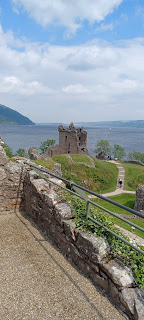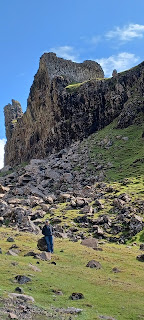Scotland is famous for its castles, in part because there are A LOT of them. An estimated 1,500 are scattered across the rugged landscape, with the earliest dating to the 12th century. Many of them are in a state of ruin or disrepair, while others have been restored (perhaps only in part), transformed, or are still in use by the British royal family, clan family legacy holders, historical preservation societies, etc.
We started at Edinburgh Castle, where we purchased a Historic Scotland annual membership because it was the best fiscal option for our extended visit. We finished at Stirling Castle, another biggie, which we’ll discuss separately. Due to the generally poor weather, we certainly got our money’s worth from our membership privileges at covered (literally and figuratively) sites.
We enjoyed storming castles – many had places to climb up and explore and they certainly make the history more vivid than a museum. Most castles were clan properties, that served as the center of the local feudal system and bear witness to Scotland’s violent history. We skipped Balmoral Castle, the Scottish summer home of the current Royal family, as the opportunity to really “visit” is quite limited.
Overlooking the Firth of Lorn, on the drive from Oban to Skye, sits Dunstaffnage Castle, the former stronghold of the "Kings of the Isles," built by clan MacDougall around 1220. At one point it was besieged and captured by Robert the Bruce, an early King of Scotland.
Eilean Donan Castle is strategically located on its own little island, overlooking the Isle of Skye. It is incredibly iconic. We didn’t enter, but only stopped for the photo opportunity of the fourth version of the castle, reconstructed in the early 1900s after its 1719 destruction.
Outside Inverness, overlooking the famous Loch Ness, are the remains of Urquhart Castle, the greatest castle in the Highlands. It came under the control of Robert the Bruce after he became King of Scots in 1306 and witnessed many historic events before and after. The views to the loch were stunning, but we didn’t waste any time looking for Nessie.
On the way from Inverness to Aberdeen we stopped at Huntly Castle, built by the Gordon family in the 16th century. We enjoyed walking through the multiple levels of the building that remains and imagining the guests they hosted.
Dunnotar Castle was one of the most impressive, even though we didn’t go inside. It is located south of Aberdeen surrounded by the North Sea. This medieval fortress on a cliff top belonged to the Earls of Marischal, a powerful family. It is famous for keeping the Scottish crown jewels safe from Oliver Cromwell’s army in the 1650s.
Outside of Dundee on the River Tay is Broughty Castle, erected in 1490 to defend against the English navy. The strategic outpost became a submarine depot in the late 19th century.
Huntingtower Castle in Perth was owned by the Ruthven family who held the young James VI (before he became king) captive there for 10 months. It was a perfect stop on a rainy day, with a full roof and two intact towers to climb.
Finally, Doune Castle is now most famous as a film location, having been used for Monty Python and The Holy Grail and Outlander, among others. Getting the actors to do parts of the audio guide was a nice touch! The amount of special effects and creative filming tactics used is fascinating to consider.
Stopping at these various castles, many of which were much less busy than more popular sights, gave us the opportunity to enjoy Scotland’s history without throngs of people. Wandering through the (mostly) ruins lets one appreciate the comforts of modern life. You have to watch your head – people weren’t so tall back then – and you can't be overly claustrophobic as there are many steep and narrow circular staircases!
And it wasn’t just castles, there were abbeys, cathedrals, forts and battlefields! That’s the next post.
Hasta pronto,
Shana & Jeff




























































